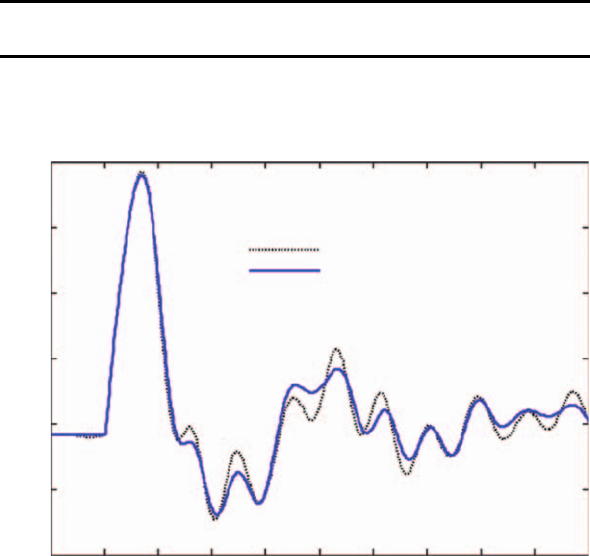
Integrate Big Data for Better Operation, Control, and Protection of Power Systems 57
Time (s)
Reduced model from the proposed method
Reduced model from traditional method
Original model
δ (deg.)
01
76.5
2
77.0
43
74.0
74.5
75.0
76.0
75.5
5769
10
8
FIGURE 4.5
Rotor angle dynamics of generator 42 (on Bus 136) following fault F1. (From S. Wang et al.,
IEEE Trans. Pattern Anal. Mach. Intell., 29, 2049–2059, 2014.)
Reduction ratio
Traditional method
Dear method
Error
0.65
0.65
0.70
0.70
0.40
0.75
0.75
0.35
0.50
0.45
0.60
0.55
0.80 0.85 0.90
FIGURE 4.6
Performance comparison between the coherency aggregation method and the DEAR
method. (From S. Wang et al., IEEE Trans. Pattern Anal. Mach. Intell., 29, 2049–2059,
2014.)

58 Handb ook of Big Data
respectively. Choose the size r of the characteristic generator set for each fault scenario to
be 9 here. Define D
g
as the number of times each generator appears as a characteristic
generator after analyzing the system dynamic response to a fault. For example, generator 2
is a characteristic generator in all the three fault scenarios; it, therefore, has a D
g
of 3. D
g
of each characteristic generator is shown in Table 4.1. Select D
g
= 2 as a threshold, that
is, generators with D
g
≥ 2 are chosen to form the super set of characteristic generators.
The following generators are selected: generators 2, 15, 18, 23, 30, 3, 4, 22, and 36. With
the super set, three different coefficient matrices C in Equation 4.8 can be obtained for the
three faults, denoted by C
1
, C
2
,andC
3
. Then a rough estimation of a generalized C can be
obtained by, for example, letting C
g
=(C
1
+ C
2
+ C
3
)/3. When another three-phase fault
takes place, for example, F4 on Lines 141–143, measurement data for the first 3 s after fault
clearance can be used to refine the coefficient matrix C
g
. Applying the recursive least-squares
method, C
g
is replaced by the more accurate coefficients in C
4
. We thus get a new reduced
model, represented by the super set of characteristic generators and the coefficient matrix
C
4
, without performing SVD. The performance of the new reduced model is illustrated in
Figure 4.7 using the rotor dynamics of generator 42.
TABLE 4.1
D
g
of characteristic generators.
D
g
3333322221111
Gen. no. 2 15 18 23 30 3 4 22 36 11 27 31 32
Time (s)
e new reduced model
Original model
δ (deg.)
01
76.5
2
77.0
43
77.5
74.5
75.0
76.0
75.5
5769108
FIGURE 4.7
Rotor angle dynamics of generator 42 (on Bus 136) following fault F4. (From S. Wang et al.,
IEEE Trans. Pattern Anal. Mach. Intell., 29, 2049–2059, 2014.)

Integrate Big Data for Better Operation, Control, and Protection of Power Systems 59
4.3 Summary
In this chapter, types of big data in power systems and acquisition are introduced. Several
big data analysis algorithms to integrate real-time big dataset for model reduction and
real-time decision making are illustrated. Both k-means clustering and DEAR methods are
presented. The network model is unchanged in the DEAR method, which makes online
applications relatively easier and more flexible (e.g., generators of interest can be retained
in the reduced model). Tests on the IEEE standard system shows that the DEAR method
yields better reduction ratios and smaller response errors under both stable and unstable
conditions than the traditional coherency-based aggregation methods. The introduced data
analysis tools can effectively integrate real-time big data for better operation, and control
andprotectionof power systems.
4.4 Glossary
Phasor measurement unit: A phasor measurement unit (PMU) or synchrophasor is a
device that measures the electrical waves on an electricity grid,usingacommontime
source for synchronization. Time synchronization allows synchronized real-time mea-
surements of multiple remote measurement points on the grid. In power engineering,
these are also commonly referred to as synchrophasors and are considered one of the
most important measuring devices in the future of power systems.
k-Means clusteri ng: k-means clustering is a method of vector quantization, originally
from signal processing, that is popular for cluster analysis in data mining. k-means
clustering aims to partition n observations into k clusters in which each observation
belongs to the cluster with the nearest mean, serving as a prototype of the cluster.
Singular value decomposition: In linear algebra, the singular value decomposition
(SVD) is a factorization of a real or complex matrix, with many useful applications
in signal processing and statistics. Formally, the SVD of an m × n real or complex
matrix M is a factorization of the form M = U ΣV ∗,whereU is an m × m real or
complex unitary matrix, Σ is an m × n rectangular diagonal matrix with nonnegative
real numbers on the diagonal, and V ∗ (the conjugate transpose of V , or simply the
transpose of V if V is real) is an n × n real or complex unitary matrix. The diagonal
entries Σ
i,i
of Σ are known as the singular values of M.Them columns of U and the
n columns of V are called the left-singular vectors and right-singular vectors of M ,
respectively.
Randomized algorithm: A randomized algorithm [13] is an algorithm that employs a
degree of randomness as part of its logic. The algorithm typically uses uniformly ran-
dom bits as an auxiliary input to guide its behavior, in the hope of achieving good
performance in the average case over all possible choices of random bits.
Model reduction: Model reduction [3] is used to produce a low-dimensional system that
has the same response characteristics as the original system with far less storage
requirements and much lower evaluation time. The resulting reduced model might be
used to replace the original system as a component in a larger simulation or it might
be used to develop a low-dimensional controller suitable for real-time applications.
60 Handb ook of Big Data
References
1. K. K. Anaparthi, B. Chaudhuri, N. F. Thornhill, and B. Pal. Coherency identification
in power systems through principal component analysis. IEEE Trans. Power Syst.,
20(3):1658–1660, 2005.
2. A. C. Antoulas. Approximation of Large-Scale Dynamical Systems. SIAM Press,
Philadelphia, PA, 2005.
3. A. C. Antoulas, D. C. Sorensen, and S. Gugercin. A survey of model reduction methods
for large-scale systems. Contemp. Math., 280:193–219, 2001.
4. D. P. Berrar, W. Dubitzky, and M. Granzow. A Practical Approach to Microarray Data
Analysis. Springer, New York, 2002.
5. C. A. Canizares, N. Mithulananthan, F. Milano, and J. Reeve. Linear performance
indices to predict oscillatory stability problems in power systems. IEEE Trans. Power
Syst., 19(2):1104–1114, 2004.
6. J. Chow, P. Accari, and W. Price. Inertial and slow coherency aggregation algorithms
for power system dynamic model reduction. IEEE Trans. Power Syst., 10(2):680–685,
1995.
7. K. Glover. All optimal Hankel norm approximation of linear multivariable systems, and
their L
∞
-error bounds. Int. J. Control, 39(6):1145–1193, 1984.
8. M. Honarkhah and J. Caers. Stochastic simulation of patterns using distance-based
pattern modeling. IEEE Tr ans. Pattern Anal. Mach. Intell., 42(5):487–517, 2010.
9. M. Kezunovic, L. Xie, and S. Grijalva. The role of big data in improving power system
operation and protection. In 2013 IREP Symposium, pp. 1–9. IEEE, Rethymno, Greece,
2013.
10. D. Lin and X. Wu. Phrase clustering for discriminative learning. Annual Meeting of
the ACL and IJCNLP, pp. 1030–1038, Suntec, Singapore, 2009.
11. S. Liu. Dynamic-Data Driven Real-Time Identification for Electric Power Systems.
University of Illinois, Urbana, IL, 2009.
12. B. Moore. Principal component analysis in linear systems: Controllability, observability,
and model reduction. IEEE Trans. Autom. Control, AC-26(1):17–32, 1981.
13. A. Nazin and B. Polyak. A randomized algorithm for finding eigenvector of stochas-
tic matrix with application to PageRank problem. In Control Applic ations, (CCA) &
Intelligent Control, pp. 412–416. IEEE, Saint Petersburg, Russia, 2009.
14. S. Z. Selim and M. A. Ismail. K-means-type algorithms: A generalized convergence
theorem and characterization of local optimality. IEEE Trans. Pattern Anal. Mach.
Intell., PAMI-6(1):81–87, 1984.
15. S. Wang, S. Lu, N. Zhou, G. Lin, M. Elizondo, and M. A. Pai. Dynamic-feature extrac-
tion, attribution and reconstruction (DEAR) method for power system model reduction.
IEEE Trans. Pattern Anal. Mach. Intell., 29(5):2049–2059, 2014.
..................Content has been hidden....................
You can't read the all page of ebook, please click here login for view all page.
